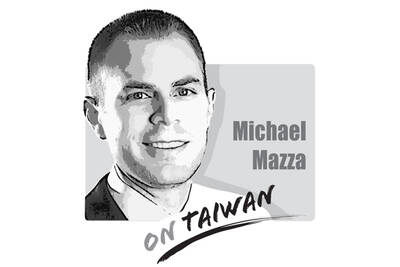On Wednesday last week, a deadly fire consumed all or part of the third, fourth and fifth floors of a building in New Taipei City’s Jhonghe District (中和).
All three floors were divided into studio apartments, with the fourth and fifth floors containing 12 and 13 respectively. The fifth floor was an illegally built rooftop extension that was divided using wooden partitions. The fire started on the fourth floor and spread within a few minutes, killing nine people and injuring two.
New Taipei City Mayor Eric Chu (朱立倫) said the police and fire departments of the city government and its predecessor, the Taipei County Government, have carried out countless household safety inspections over the past 10 years, but there is a legal loophole regarding “existing illegal structures” built before 2007.
Laws and regulations should be interpreted and implemented more strictly, Chu said.
The alleged arsonist and the landlord should be harshly punished under the law, but does the New Taipei City Government bear no legal responsibility?
How can it be that every time this kind of incident occurs, the government condemns the perpetrator, punishes the landlord and blames legal loopholes, but does not bear any legal responsibility?
Article 77-2 of the Building Act (建築法) and the Administrative Regulations on Indoor Decoration of Buildings (建築物室內裝修管理辦法) say that authorities have the right and duty to manage the interior decoration of buildings, while Article 77, Paragraph 2 of the act says that authorities have the right and duty to send personnel at any time to inspect the maintenance of structures and equipment related to public safety in buildings.
As for illegally built structures, Article 97-2 of the act and Article 11-1 of the Regulations for the Handling of Illegal Structures (違章建築處理辦法) say that when an illegal structure poses a threat to public safety, the local authorities responsible for managing buildings should draw up a plan for demolishing it and do so before a given deadline.
The building’s owners did not install fire prevention, escape and safety equipment or fire compartments, and did not use fire-resistant building materials, as required by law, leading to the deaths of nine people.
Did this happen because of legal loopholes or because of the city government’s failure to enforce the law? In view of the above legal requirements, the answer should be obvious.
This case highlights the effects that illegal structures have on public safety. The government should be more proactive in dealing with all of the nation’s illegal structures.
If, in the process of enforcing the law, government authorities are constrained by a lack of professional ability or personnel, they should entrust specialized tasks to architects’ associations and other professional bodies.
The cooperative efforts of government and private partners can ensure the safety of citizens’ living environments and prevent similar events from happening again.
Li Jen-hao is a lawyer, architect and an assistant professor at National Chiao Tung University’s Graduate Institute of Architecture.
Translated by Julian Clegg
The US Senate’s passage of the 2026 National Defense Authorization Act (NDAA), which urges Taiwan’s inclusion in the Rim of the Pacific (RIMPAC) exercise and allocates US$1 billion in military aid, marks yet another milestone in Washington’s growing support for Taipei. On paper, it reflects the steadiness of US commitment, but beneath this show of solidarity lies contradiction. While the US Congress builds a stable, bipartisan architecture of deterrence, US President Donald Trump repeatedly undercuts it through erratic decisions and transactional diplomacy. This dissonance not only weakens the US’ credibility abroad — it also fractures public trust within Taiwan. For decades,
The government and local industries breathed a sigh of relief after Shin Kong Life Insurance Co last week said it would relinquish surface rights for two plots in Taipei’s Beitou District (北投) to Nvidia Corp. The US chip-design giant’s plan to expand its local presence will be crucial for Taiwan to safeguard its core role in the global artificial intelligence (AI) ecosystem and to advance the nation’s AI development. The land in dispute is owned by the Taipei City Government, which in 2021 sold the rights to develop and use the two plots of land, codenamed T17 and T18, to the

The ceasefire in the Middle East is a rare cause for celebration in that war-torn region. Hamas has released all of the living hostages it captured on Oct. 7, 2023, regular combat operations have ceased, and Israel has drawn closer to its Arab neighbors. Israel, with crucial support from the United States, has achieved all of this despite concerted efforts from the forces of darkness to prevent it. Hamas, of course, is a longtime client of Iran, which in turn is a client of China. Two years ago, when Hamas invaded Israel — killing 1,200, kidnapping 251, and brutalizing countless others
Taiwan’s first case of African swine fever (ASF) was confirmed on Tuesday evening at a hog farm in Taichung’s Wuci District (梧棲), trigging nationwide emergency measures and stripping Taiwan of its status as the only Asian country free of classical swine fever, ASF and foot-and-mouth disease, a certification it received on May 29. The government on Wednesday set up a Central Emergency Operations Center in Taichung and instituted an immediate five-day ban on transporting and slaughtering hogs, and on feeding pigs kitchen waste. The ban was later extended to 15 days, to account for the incubation period of the virus